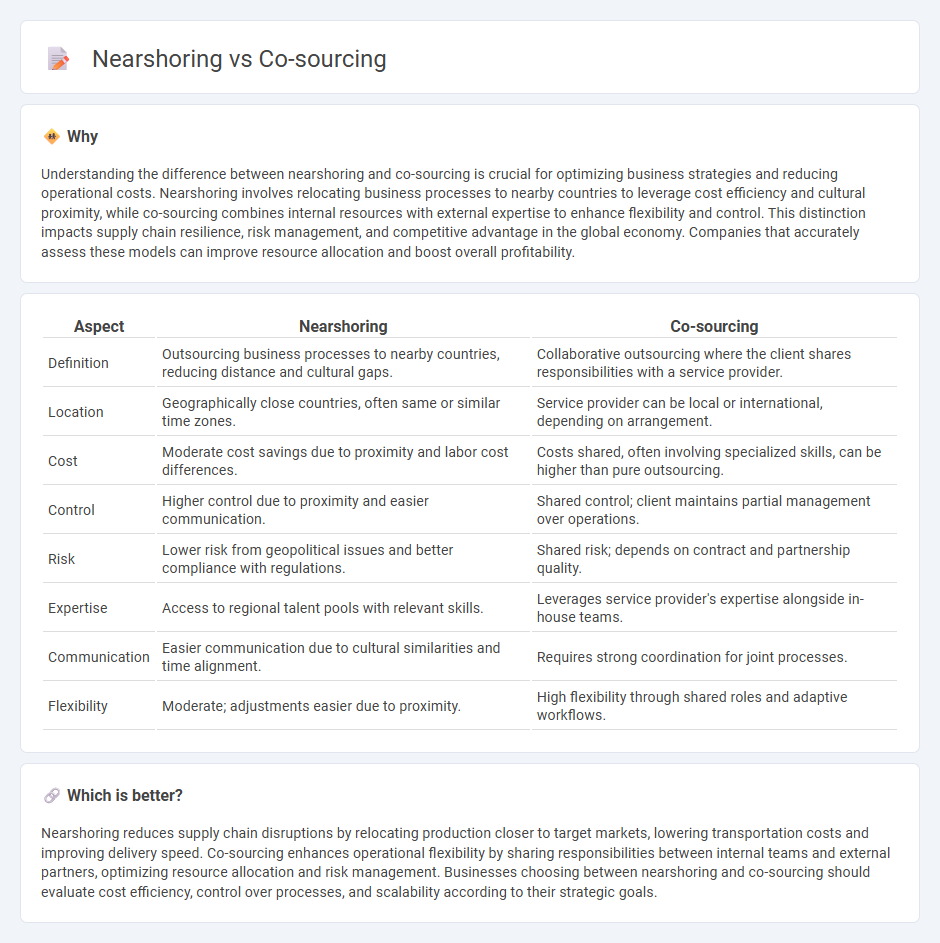
Nearshoring involves relocating business processes to nearby countries to reduce costs and improve supply chain efficiency, while co-sourcing combines internal resources with external providers to enhance flexibility and expertise. Both strategies aim to optimize operational performance and risk management in a dynamic global economy. Discover how nearshoring and co-sourcing can transform your business strategy.
Why it is important
Understanding the difference between nearshoring and co-sourcing is crucial for optimizing business strategies and reducing operational costs. Nearshoring involves relocating business processes to nearby countries to leverage cost efficiency and cultural proximity, while co-sourcing combines internal resources with external expertise to enhance flexibility and control. This distinction impacts supply chain resilience, risk management, and competitive advantage in the global economy. Companies that accurately assess these models can improve resource allocation and boost overall profitability.
Comparison Table
| Aspect | Nearshoring | Co-sourcing |
|---|---|---|
| Definition | Outsourcing business processes to nearby countries, reducing distance and cultural gaps. | Collaborative outsourcing where the client shares responsibilities with a service provider. |
| Location | Geographically close countries, often same or similar time zones. | Service provider can be local or international, depending on arrangement. |
| Cost | Moderate cost savings due to proximity and labor cost differences. | Costs shared, often involving specialized skills, can be higher than pure outsourcing. |
| Control | Higher control due to proximity and easier communication. | Shared control; client maintains partial management over operations. |
| Risk | Lower risk from geopolitical issues and better compliance with regulations. | Shared risk; depends on contract and partnership quality. |
| Expertise | Access to regional talent pools with relevant skills. | Leverages service provider's expertise alongside in-house teams. |
| Communication | Easier communication due to cultural similarities and time alignment. | Requires strong coordination for joint processes. |
| Flexibility | Moderate; adjustments easier due to proximity. | High flexibility through shared roles and adaptive workflows. |
Which is better?
Nearshoring reduces supply chain disruptions by relocating production closer to target markets, lowering transportation costs and improving delivery speed. Co-sourcing enhances operational flexibility by sharing responsibilities between internal teams and external partners, optimizing resource allocation and risk management. Businesses choosing between nearshoring and co-sourcing should evaluate cost efficiency, control over processes, and scalability according to their strategic goals.
Connection
Nearshoring and co-sourcing are interconnected strategies that enhance operational efficiency by relocating business processes closer to the company's home country while sharing resources with external partners. Nearshoring reduces supply chain risks and costs through geographic proximity, whereas co-sourcing combines internal teams with specialized external expertise to optimize performance and innovation. This synergy enables companies to improve agility, reduce expenditures, and strengthen competitive advantage in a dynamic global economy.
Key Terms
Resource Allocation
Co-sourcing enables organizations to share resource allocation responsibilities with external partners, optimizing workforce flexibility and skill specialization. Nearshoring leverages geographic proximity to allocate resources efficiently, reducing communication delays and operational costs. Explore detailed strategies to enhance resource allocation through co-sourcing and nearshoring models.
Geographic Proximity
Co-sourcing integrates internal resources with external partners, often within the same country, enhancing collaboration and control through close geographic proximity. Nearshoring involves outsourcing business processes to neighboring countries, leveraging time zone alignment and cultural similarities to improve efficiency and communication. Explore the benefits and challenges of co-sourcing versus nearshoring to optimize your business strategy.
Cost Efficiency
Co-sourcing reduces operational costs by sharing resources and responsibilities between internal teams and external partners, optimizing workforce efficiency without full outsourcing. Nearshoring offers cost advantages through proximity, lower labor costs, and reduced shipping expenses compared to onshore models. Discover how co-sourcing and nearshoring strategies can enhance cost efficiency tailored to your business needs.
Source and External Links
What is co-sourcing? - Co-sourcing is the hybrid model of combining internal staff with external experts who work side-by-side as an integrated part of the team, maintaining control while gaining specialist skills and flexibility.
How is Co-Sourcing Transforming Private Capital Operations? - Co-sourcing allows firms to collaboratively share responsibilities between internal staff and third-party providers, preserving control and customizing partnering based on strengths without disrupting operations.
What is co-sourcing and how does it help? - Co-sourcing introduces external expertise to in-house teams through a hybrid work setup where outsourced members work alongside internal employees to achieve shared goals, improving cost efficiency and quality.
 dowidth.com
dowidth.com